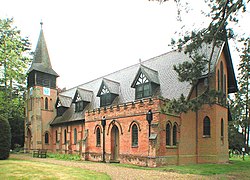Kelvedon Hatch
| Kelvedon Hatch | |
| Essex | |
|---|---|
 St Nicholas, Kelvedon Hatch | |
| Location | |
| Grid reference: | TQ576986 |
| Location: | 51°39’48"N, -0°16’42"E |
| Data | |
| Population: | 2,563 (2001) |
| Post town: | Brentwood |
| Postcode: | CM15 |
| Dialling code: | 01277 |
| Local Government | |
| Council: | Brentwood |
| Parliamentary constituency: |
Brentwood and Ongar |
Kelvedon Hatch is a village in central Essex, to be found just north of Pilgrims Hatch, some four miles north of Brentwood. It is surrounded by the Metropolitan Green Belt.
The village today is no longer a rural backwater with a large proportion of its population commuting to work elsewhere. It has a population of 2,563 recorded in 2001.
The parish is the location of the "Kelvedon Hatch Secret Nuclear Bunker", the largest and deepest cold war bunker open to the public in the south-eastern counties. It is still signposted as "Secret nuclear bunker" despite being well-known, publicised and much visited.
The parish church is St Nicholas, which was built in 1895, replacing the original parish church, also St Nicholas, which was outside the village on the Kelvedon Hall estate. Today's church was built in the arts and crafts style.
History
The name of the village is recorded variously as Kelenduna, Kalenduna and Kelvenduna in the Domesday Book. The name means "Speckled Hill". From its early days in the Middle Ages until the mid-20th century the main activity in Kelvedon Hatch was agriculture. Records from 1871 show 82 households of which showed only 3 'white collar' households and 4 landowners or of independent means, with the majority of the rest engaged in a local agricultural economy.
During the Victorian age, many younger people gravitated towards the main towns, encouraged by railway links at Ongar and Brentwood and the decline in the local 'agriconomy' has its roots in that exodus.
Around the village
Kelvedon Hall
First mentioned in the Domesday Book, the main estate building of the village was Kelvedon Hall. The manor was sold to John Wright a yeoman from South Weald in 1538 and it remained in the family until the early 20th century. The manor house was rebuilt in the 18th century by the seventh John Wright.
The village's parish church, St Nicholas' Church, stood within the estate adjacent to the manor house. It is dated back to 1372 and may have existed before that. This church though was abandoned in 1895 in favour of a church in the main village.
Other estate
Other mansions in the area of Kelvedon Hatch are Brizes, originally built in the late 15th century with the current building on the site dating back to the 1720s; and Great Myles, named for Miles de Muntenay, dating back to the Domesday Book but was largely demolished in 1837 although a few subsidiary buildings remain today.
To the west of Kelvedon Hatch, at Kelvedon Common, lies Dudbrook Hall, once owned by the Waldegrave family and which dates back to 1602. During Second World War it was used to billet RAF officers based at Stapleford[1] and Weald aerodromes. It is now a care home for the elderly.[2]
Secret Nuclear Bunker
Ther Kelvedon Hatch Secret Nuclear Bunker, the largest and deepest cold war bunker open to the public in the south=eastern counties.[3]
Hidden in a wood off the A128 Ongar (now well signposted for the tourist trade), Brentwood Road, is a small bungalow (guardhouse) which hides a three-level bunker complex 125 feet underground; a long corridor leads down to a place in which up to 600 people would have been confined behind blast-proof doors in the event of a nuclear war. The bunker was originally built in 1952/3 by the construction firm Peter Lind & Company Ltd, as part of ROTOR, an urgent government building programme to improve Britain's air defence network and became the Sector Operations Command for the RAF Fighter Command with responsibility for the London Sector. It subsequently became adopted as a potential 'regional government bunker' as the threat of nuclear war grew in the 1960s. It was maintained thereafter for the rest of the Cold War.
The bunker was sold in the 1990s and is now a tourist attraction and film location. The bunker is currently owned and operated by the family who originally owned the land before the military moved in. It has a many historical items remaining intact including a BBC studio. A souvenir shop in the original canteen sells items, including government literature produced for the public in the early 1980s.
Outside links
| ("Wikimedia Commons" has material about Kelvedon Hatch) |
- Kelvedon Hatch Parish Council
- History House - St Nicholas, Kelveton Hatch
- Kelvedon Hatch Secret Nuclear Bunker
References
- ↑ "The third shall be the first". http://www.flysfc.com/ourhistorycommercial.html. Retrieved 17 May 2011.
- ↑ "Dudbrook Hall". http://www.stmichaelshomesltd.com/dudbrook_hall.htm. Retrieved 17 May 2011.
- ↑ Were we really that scared?: article in Daily Telegraph Travel section by Sophie Campbell Saturday 22 September 2007 (Issue no 47,730)